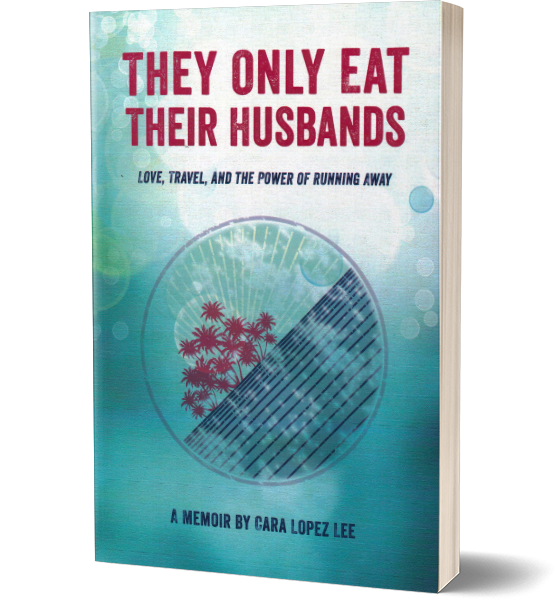Heading south on Route 66 from Springfield, Illinois, Stephanie and I take a detour at Glenarm to see an old covered bridge to nowhere. The red, wooden, barnlike structure with the white-fenced ramp was built in 1880. If you’ve watched The Bridges of Madison County, you get the idea. The bridge crosses Sugar Creek, a peaceful spot bordered by trees, where wagons once rolled through to continue down the dirt road on the other side. Now it’s like one of those haunted houses with doors that open onto walls: I walk across the bridge to a dead end. This is no longer a path to someplace else, just a scenic backdrop for picnics. So it is that past gives way to present: forgotten but not gone.

This covered bridge in Glenarm, Illinois was built in 1880.
In Litchfield, we stop at a couple of sights right on Route 66 and still open for business: the Sky View Drive-in movie theatre, in operation since 1951, and the Ariston Café, at its present location since 1935, although aging neon signs out back show where the old Route 66 used to pass by on the other side. The neon letters that once declared the Ariston a “Better Place to Eat” are now half-hidden behind giant bins on the cafe’s backside: a gravestone marker overlooking the cracked, overgrown remains of the original Mother Road.


The Ariston Café has stood in Litchfield since 1935. Aging neon signs out back show where the old Route 66 used to pass by on the other side.
In Mount Olive, we stop at the Soulsby Shell gas station, built in 1926. It was first owned by Henry Soulsby, then by his son and daughter, Russel and Ola. The Soulsbys pumped gas from two old-fashioned, round-faced, yellow-and-red pumps until 1991. This departed family business recalls the spirit of old Route 66, but it also serves as a reminder that time brings an end to all things.

The tiny Russel Soulsby gas station pumped gas from two old-fashioned round-faced pumps from the 1920s into the 1990s.
Just before crossing the state line into Missouri, we stop at the Luna Café, an authentic old roadhouse built in 1924. It once featured gambling in the basement and sporting women upstairs. But we’re just interested in the main floor, where our guidebook says we can grab a bite to eat. Steph – whose chest now hurts so much we’re planning to find a doctor in Saint Louis – voices uncharacteristic optimism about the food. I take over the pessimistic view: I’m afraid to eat here, based on the faded and peeling dark wood siding, and the four pickups, monster SUV, and old beater parked in the lot. I volunteer to go in alone as a scout while Steph waits in our rental car for a report.

The Luna Café is listed in two of our guidebooks as an “authentic old roadhouse” where we can grab a bite to eat, but I’m afraid to eat here.
Inside, the joint is that kind of dark meant to hide women’s wrinkles and men’s broken blood vessels. Middle-aged beer bellies line the bar. A woman who seems about 50 but is probably 35, turns sagging breasts, drooping smile, and dangling cigarette my way. I picture her long, untamed hair finding its way into the occasional burger. A rectangle of green pool-table felt swallows the pulp-fiction blue light from the neon Route 66 sign. A flyer tacked to a post says something about pizza. I return to the car and tell Steph, “It’s definitely a roadhouse, in every sense you’d expect. You might or might not want to eat here, but you absolutely have to come inside.” It’s not often one has an opportunity to see an American crime-thriller cliché reenacted in real life.

Inside, the joint is that kind of dark meant to hide women’s wrinkles and men’s broken blood vessels.
The next 10 minutes are neither wholesome nor useful, but my exhausted friend has finally embraced awful as interesting. As we enter, a car-wreck of a man with a lumpy red potato of a drinker’s nose teeters past us on his way out into the dying light.
He leers at us. “Well, maybe I should go back in. If I’d known you were coming, I wouldn’t have left.”
We grant him a laugh.
“Well, that’s funny, isn’t it?” he wheezes. “Isn’t that funny?”
We abandon him for the bartender. “Do you serve food?” I ask.
“Well…” She pauses, her face pleading for us to decide we aren’t as hungry as we thought. “Whaddaya want?”
Steph and I exchange a look. Don’t we need a menu for that answer?
“See, the thing is we’re about to do change of shift,” the barkeep explains, “which makes it kind of hard because the bartenders do all the cooking. So if you could wait about half an hour…”
“I don’t want to wait,” Steph says.
“What do you want?” Her tone isn’t unfriendly, just consummately weary.
“We’re not sure…” If this woman is going to withhold info, so is Steph.
“I could make you a hamburger or a roast beef sandwich or something like that.”
When we bring up the only advertised food item, pizza, she informs us that the pizza-guy isn’t in. “He just got a new Harley and he had to take it on the road for a test-drive. There’s no telling when he’ll be back.”
We decide not to eat here. I take a few photos while the slurred and smoky line-up of beer bellies asks Steph where we’re from and where we’re headed. A couple of guys warn her to be careful on the other side of the bridge because “the blacks live over there and it isn’t safe.” If nothing else, this makes us happier about our decision not to eat here.

We decide not to eat here.
As Steph and I discuss dinner options, the bartender suggests the “Waffle House.”
I guffaw, certain she’s joking. “We’re not going to the Waffle House,” I assure Steph.
Then the bartender leans toward my friend, “Have you ever been to a Waffle House?”
“No.”
“Oh, it’s really good.” She’s serious.
“Yeah, at 3:00 in the morning when nothing else is open,” I concede.
“No, I really like it. That’s good food.” She has the dreamy look of someone whose mouth is watering at the thought of creepy little omelettes with American cheese slices half-melted in the fold. “Especially when you’re drunk,” she confides.
We hurry out of there before I fall into a giggling fit at this woman’s expense. No sense risking the addition of a roadhouse bar-brawl to our authentic Route 66 experience, though I’m sure Steph would have my back. As we drive away, she deadpans, “I wisely decided not to ask them to suggest a good place to stay.” And I remember why I’ll always maintain an open road back to this friendship — first built in 1981.




